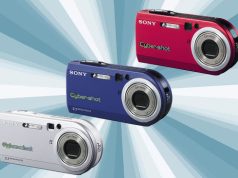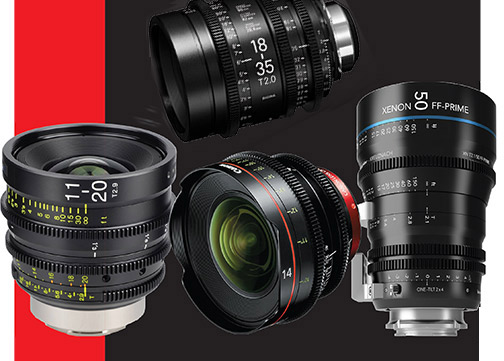
Specialized cine lenses are one of the hottest niches in the upmarket optical space. That’s because they’re specifically targeted at the increasing number of video shooters determined to take their filmmaking and video productions to a truly professional level.
Designing and manufacturing cinema lenses is especially demanding. It requires an exceptionally high level of mechanical as well as optical precision. Fortunately for dealers and consumers alike, a number of leading optical manufacturers have risen to the challenge. Consequently, there is a plethora of awesome new cine lenses, including the examples covered here.
No matter what kind of camera your customers are using to capture video, true purpose-built cine lenses provide a great way to achieve pro-caliber results. True cine lenses offer greater, more precise control of the recorded image; provide a more seamless shooting experience; and ultimately deliver superior flexibility as well as enhanced video performance.
Six Reasons Why Cine Lenses Are Best for Capturing Pro-Level Video
1. Cine lenses always have smooth operating (de-clicked, stepless) mechanical aperture rings. They also feature extremely smooth zoom controls and ultrasmooth, long-throw manual focusing controls. Moreover, these controls usually have standardized external gears that mate with integral or modular servo-control mechanisms for even smoother, more predictable operation in the field. However, many experienced filmmakers prefer manual control rings because they’re quicker (no time lag) and more intuitive. And because they also provide a more sensitive feel than electronically controlled systems.
2. Cine lenses are almost always parfocal; in other words, they maintain focus at the set value as videographers zoom or change apertures, instead of “breathing” (shifting focus when settings are altered). Breathing can happen with DSLR and mirrorless lenses designed primarily for general-purpose or still picture shooting. Many use internal focus systems that tend to suppress focus shifts and off-axis changes.
3. Cine lenses typically feature very high build quality. Most employ rugged, weatherproof construction. They also feature internal zoom and focus controls to maintain constant physical length and weight balance at all settings.
4. Cine lenses are usually precision calibrated in T stops to ensure uniform light transmission. Their calibrated scales are totally reliable. Moreover, the diameters of their front filter rings and their overall feel and balance are typically uniform over a given lens line. In addition, they usually don’t have parts that protrude during focusing or zooming.
5. Cine lenses generally have matching imaging characteristics, such as color balance and contrast, within a given brand. They’re also designed to be easy to service, and they typically deliver optical performance of the highest caliber.
6. Cine lens manufacturers strive to keep the most common focal lengths at roughly the same weight and with similarly configured controls. This assures uniform balance and handling characteristics.
It’s true that cine lenses often represent a substantial investment. However, if your customers are serious about capturing pro-caliber video, or if they’re moving up from filming with a DSLR or mirrorless camera to a full-fledged pro video rig, make sure they take a look at the cinema lenses detailed here. They are all great choices for accomplished and emerging videographers.
Specialized Cine Lenses
Sigma 18–35mm T2
In Sigma’s Cine High-Speed Zoom family, this compact wide zoom delivers outstanding image quality and covers a popular focal-length range. It features a wide 28.4mm image circle that accommodates Super 35mm-format sensors. And its fast T2 maximum aperture facilitates low-light shooting. The lens also achieves ultrasmooth, long-throw, 180° focusing for optimum control.
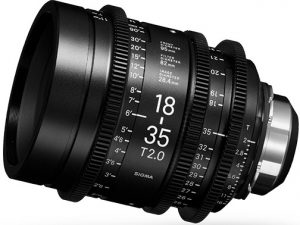
Notably, a click-free, 60°-turn, 9-blade iris enriches its artistic bokeh, creating smooth, natural out-of-focus image areas. What’s more, its internal focus design maintains a constant length for consistent balance. Other features include a zoom ring that rotates in a smooth 180° turn for precise image control; all three lens-control rings incorporate standard 0.8 Mod gearing compatible with optional servo systems; and it comes with a removable lens support foot. In Canon EF, Sony E and PL (Arri Positive Lock) mounts, $3,999.
Tokina Cinema ATX 11–20mm T2.9
Tokina’s impressive low-distortion super-wide zoom lens covers Super 35mm sensors. Moreover, its interchangeable Canon EF mount is swappable for LPL, PL, Sony E, Micro Four Thirds (MFT) and also Nikon F mounts for the ultimate in optics versatility. In addition, the cinema lens is parfocal to maintain focus while zooming. It also provides a constant T2.9 maximum aperture and has standard 0.8 Mod lens gears for all functions.
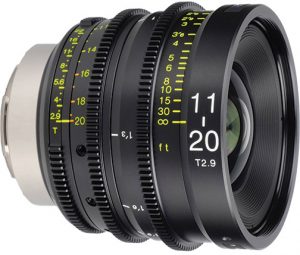
What’s more, a 9-bladed aperture ring enhances its attractive bokeh. A 12-inch minimum focus distance also helps create compelling close-ups. It also features an all-metal housing and an 86mm filter thread. In addition, it comes with a carry pouch. $2,399.
Sony E PZ 18–110mm f/4 G OSS
This versatile, lightweight zoom has separate, smooth-action control rings for focus, zoom and aperture. Additionally, it employs built-in Optical SteadyShot (OSS) image stabilization to minimize the effects of camera shake. Its 18–110mm zoom covers the most frequently used range for Super 35mm/APS-C movies with a constant f/4 maximum aperture. And its G series optical performance delivers image quality suitable for 4K production.
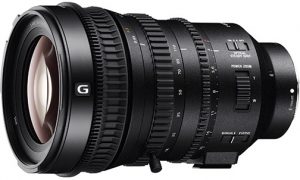
It also employs Sony’s SMO (smooth motion optics) construction to minimize optical shifts that have a negative impact on movie quality. The parfocal lens incorporates six aspherical and two ED elements to maximize image quality and a 7-blade circular aperture. Other features include manual and servo zoom options as well as internal focusing. Beautifully finished in satin black, it comes with a removable tripod foot. In APS-C/Super 35 E mount, $3,649.99.
Zeiss CP.3 21mm T2.9
This remarkable, recently upgraded, fast wide-angle prime lens from Zeiss covers the full-frame format. The compact cinema lens has standard geared iris and focus controls. In addition, it features a click-less aperture ring with a 14-blade diaphragm for beautiful, artistic bokeh. Moreover, new lens coatings also increase light transmission and enhance contrast.
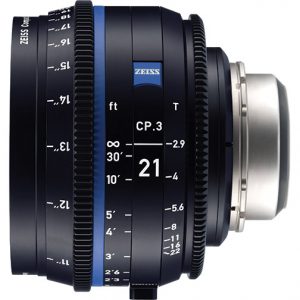
Further, its compact design is optimized for even weight distribution as well as improved balance. Of course, the lens delivers the “classic Zeiss image rendering” with smooth natural transitions. Metric distance scales are also integrated. In Canon EF or PL mount, $4,390. zeiss.com
Canon CN-E 14mm T3.1 L F
This is Canon’s latest L-series ultrawide-angle, full-frame prime cine lens. It offers an impressive 132.2º diagonal field of view (104.3ºx81.2º on full frame and 82.6ºx52.5º on Super 35). Its 11-blade diaphragm enhances rounded out-of-focus highlights and natural bokeh. And its long-throw focusing helical provides 300° of smooth, stepless rotation to bring it from infinity to its 31.5-inch minimum focusing distance.
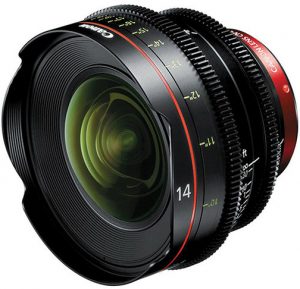
The lens is also designed to minimize focus breathing. And innovative glass construction counteracts the effects of barrel expansion due to temperature variations. Its large diameter aspheric lens and anomalous dispersion glass deliver high contrast and sharp imaging from center to edge. Other features include dual distance markings on both sides of the barrel; dust and weather resistance; 36° iris rotation; and focus and gear locations matching other Canon CN-E lenses. At 3.7 inches in length, it weighs a portable 2.65 pounds. In Canon EF mount, $3,999.
Venus Optics Laowa 12mm T2.9 Zero-D
This new cinema lens offers an ultrawide 122º angle of view with impressive image quality and low distortion on full-frame sensors. It’s ideal for capturing landscapes as well as shooting in tight interior spaces. Lightweight at 1.49 pounds and compact (3.4 inches long), its relatively wide aperture facilitates creative depth-of-field effects. Additionally, its 7-blade diaphragm enhances pleasing, natural bokeh.
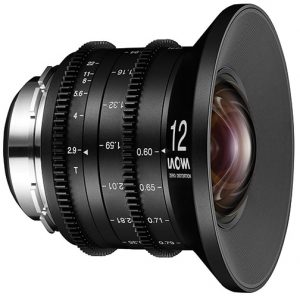
Moreover, the Venus Optics lens focuses down to 7 inches for compelling close-ups. It also easily attaches to stabilization systems, including handheld gimbals. Other features include a standard 0.8 pitch gearing on focus and aperture rings, as well as a wide 102mm diameter front ring that steps up to 114mm with the included adapter to fit standard matte boxes. It comes with a waterproof, hard-shell, foam-lined Pelican case. In PL, Sony E and Canon EF and RF mounts, $1,499.
Rokinon 50mm T1.5 XEEN CF Pro
This attractive, wide-aperture, normal prime Rokinon cinema lens features a lightweight carbon fiber housing. The notably compact lens is built for full-frame cameras with a 46.2° field of view (31.2° on Super 35). It employs multilayer X-coating technology for flare control and consistent color balance. And its luminous markings facilitate low-light use. In addition, it features dual-calibrated right- and left-side distance and T-stop scales. Smooth geared focus and aperture controls help focus pullers and facilitate motorized control.
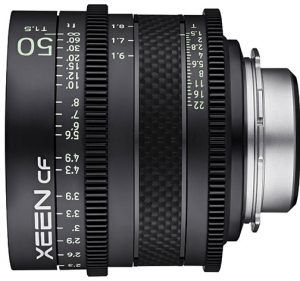
It also incorporates an 11-blade diaphragm for low-light performance and to enhance its attractive bokeh. In addition, it provides a close minimum focus distance of 17.7 inches and has a de-clicked aperture ring for silent adjustments on the fly. A front diameter of 95mm permits easy use of matte boxes. In PL, Sony E and Canon EF mounts, $2,495.
Sigma 50–100mm T2
This high-performance, moderate telephoto zoom is part of Sigma’s Cine High-Speed Zoom line. With a constant T2 maximum aperture, it has a large 28.4mm image circle covering full-frame as well as Super 35 sensors. The lens features industry standard 0.8 Mod gearing on its long-throw focus, aperture and zoom rings to facilitate rapid lens changes. It also employs an internal focus system to maintain balance and assure image quality over its entire range. Moreover, a rounded 9-blade diaphragm enhances its beautiful bokeh, and its 95mm front diameter is compatible with matte boxes.
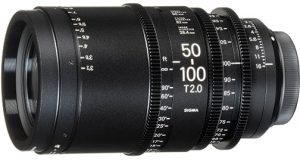
In addition, it has an 82mm front filter thread and a removable 1/4-inch x 20 support foot that mates with an optional rod-mounted lens support for added stability. Sigma’s 50–100mm boasts dustproof, splashproof construction with seals on every ring as well as the lens mount. Additionally, its main markings are in luminous paint to enhance visibility and its all-metal body and laser engraved scales ensure long-term durability. In PL, Sony E and Canon EF mounts, $3,999.
Schneider Xenon 50mm T2.1 FF-Prime Cine-Tilt
This innovative Schneider full-frame normal lens in the Sony E mount provides a +/- 4° tilt option via a 120° rotation of the tilt control ring. As a result, it enables precise changes in the focus plane, providing extended creative control of depth of field. However, when the tilt is set to 0º, it functions like a conventional lens. Color matched to intercut with other Schneider cine lenses, it features minimized breathing and covers the full frame with virtually no vignetting.

Designed for 4K capture, it incorporates a 14-blade diaphragm to create classic Hollywood style bokeh. In addition, the lens features industry standard 0.8 Mod gearing for controlling focus, iris and tilt. Also, its 300º lens barrel rotation facilitates precise focus point control. Other features include a 40° angle of view on a full-frame camera, 28° on Super 35, as well as a 19.7-inch minimum focusing distance. It measures 6.35 inches and weighs 3.1 pounds. In Sony E mount, $5,599.
SLR Magic 2x Anamorphot Cine 35mm T2.4
Up till now, SLR Magic has offered traditional cine-style lenses and anamorphic adapters. Now they’ve taken the logical step and combined the two concepts in their first anamorphic lenses. This new lens is designed for cameras with Micro Four Thirds mounts and sensors. Notably, it provides a 2x anamorphic squeeze, yielding a 2.35:1 aspect ratio in the 16:9 format. As a result, videographers can record an aspect ratio wider than the sensor’s native aspect ratio without cropping the image, thus maximizing resolution and detail.
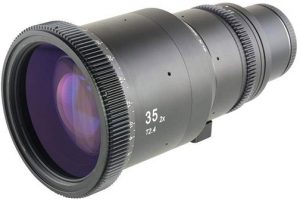
In addition, it provides standardized gearing on the focus and iris control rings for use with follow focus units. It also has an 82mm threaded front ring for mounting filters. Other features include a 3.5-foot minimum focus distance; 11 aperture blades; a length of 7.6 inches; and a weight of 3 pounds. It comes with a robust hard case. $2,599.
Sigma 105mm T1.5
This impressive new addition to Sigma’s FF High-Speed Prime line is now available in the PL/i mount. The mount incorporates Cooke /i Technology that generates lens metadata to assist in post- and visual-effects production. The compact, lightweight, medium telephoto lens provides full-frame coverage at 6–8K resolution. It incorporates a rounded 9-blade diaphragm to augment its smooth bokeh. It also provides a 180° focus rotation for precise focusing.

Additionally, the 105mm T1.5 features standard 0.8 Mod gearing on all control rings, including the click-less 60° rotation iris diaphragm. Moreover, it provides a horizontal angle of view of 19.5° on full frame, 13.4° on Super 35, and 12.9° on APS-C format sensors. All markings are engraved for durability and select scales are in luminous paint for low-light visibility. Other features include dust and moisture resistance, as well as a commendably close 40-inch minimum focus distance. In PL, Sony E and Canon EF mounts, $4,999; in PL/i mount, $5,499.


